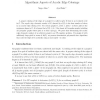10 search results - page 1 / 2 » An expected polynomial time algorithm for coloring 2-colorab... |
DMTCS
2011
12 years 9 months ago
2011
Abstract. We present an algorithm that for 2-colorable 3-uniform hypergraphs, finds a 2-coloring in average running time O(n5 log2 n).
SSS
2010
Springer
13 years 7 months ago
2010
Springer
In this paper we present new distributed protocols to color even rings and general bipartite graphs. Our motivation is to provide algorithmic explanation for human subject experime...
MFCS
2005
Springer
14 years 2 months ago
2005
Springer
Abstract. Feige and Kilian [5] showed that finding reasonable approximative solutions to the coloring problem on graphs is hard. This motivates the quest for algorithms that eithe...
ALGORITHMICA
2002
13 years 9 months ago
2002
A proper coloring of the edges of a graph G is called acyclic if there is no 2-colored cycle in G. The acyclic edge chromatic number of G, denoted by a (G), is the least number of...
COMPGEOM
2009
ACM
14 years 3 months ago
2009
ACM
Color red and blue the n vertices of a convex polytope P in R3 . Can we compute the convex hull of each color class in o(n log n)? What if we have χ > 2 colors? What if the co...

